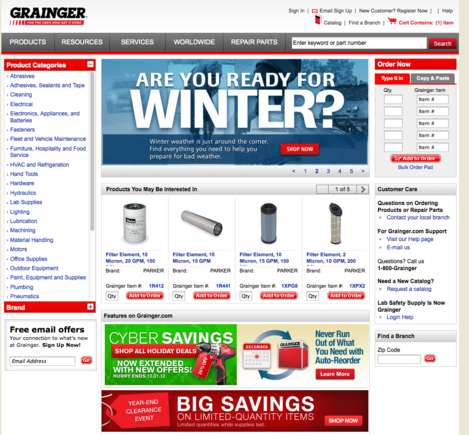As sales channels become more complex, many business-to-business companies — including brand manufacturers — face the dilemma of whether to sell online directly to their customers.
Likewise, there are many business-to-consumer stores that are large enough to command low inventory prices from manufacturers and thus can consider selling directly to other businesses or even acting as a wholesale distributor.
Does it make sense to try to play both sides? It depends. This article examines a few key differences to consider between B-to-B and B-to-C online stores as you evaluate your strategic plans.
Customer Experience
In the past, many observers believed that web design for B-to-B sites was not important. Their view was that most sales were to repeat customers who knew what they were looking for. Product reviews were presumably risky. And sales staffs usually did the real selling. In many cases, online B-to-B stores were merely an extension of a printed catalog. The customer experience was minimal. The goals of a B-to-B site were presumably to expose the existing product catalog, provide payment options, and pick up some incremental revenue. In other words, there was little belief that ecommerce was going to add much to the top or bottom line.
Not any more. Progressive B-to-B companies are looking to grow their revenue and gain market share by providing compelling online buying experiences. B-to-B ecommerce merchants now design their websites much the same as the leading B-to-C ones. B-to-B merchants use sophisticated guided site search. Their web designs are elegant. Personalization and merchandising are aggressively used for upsells and cross-sells. Product reviews and social media use are abundant, as are integrated inventory controls and multiple fulfillment options.
Here is a screen shot of a well-known B-to-B innovator, W.W. Grainger, which sells industrial supplies and equipment.
Grainger is a B-to-B innovator.
At first glance, Grainer.com is like any leading retailer. The company has invested heavily in a world-class customer experience. After all, hydraulic-hose buyers also presumably shop on Amazon and expect the same level of sophistication and personalization.
Lead-to-order Process
In a B-to-C site, the goal is to have visitors buy something during their visit or at least complete an intermediate action, such as creating a wishlist or subscribing to an email newsletter. The lead-to-order process is typically short, as the buyer is usually the decision maker who is paying for the order with a credit card or PayPal.
With B-to-B stores, the buyer is frequently representing a corporation. The buyer may need a formal quote and then issue a purchase order for payment. The ecommerce system must store the quote for a lengthy approval process.
Conversely, the buyer may be authorized to purchase with a corporate credit card, but that buyer must be registered and authorized to make purchases within the client account on the B-to-B site. In some cases, the items being acquired will need to be allocated from inventory to assure availability when the buyer approves the quote.
Additionally, many corporate accounts have highly customized pricing and delivery schedules. The B-to-B ecommerce platform must be tightly integrated with accounting, inventory, and order fulfillment systems. Most B-to-C shopping carts are not equipped for this level of sophistication.
Order-to-cash Process
Once an order is received, B-to-C companies generally ship it and charge the buyer’s credit card. An order confirmation is generally sent out via email, completing the process.
In a B-to-B company, this process is generally more complex. Orders may be shipped from the warehouse closest to the end customer. Invoices and shipping manifests need to be generated that reference the purchase order number.
The buyers’ receiving departments will check-in the orders, facilitating the authorizing of payments. They entire process from order to cash may be months.
Inventory
In general, B-to-B sellers need a broader and deeper inventory in stock. Many B-to-C merchants who shift to B-to-B quickly find that their inventory levels are inadequate to support the more volatile and demanding B-to-B customer.
Sales Channels and Compensation
With B-to-C sales, there is generally no sales-channel splits or sales representative salaries to worry about. There are sometimes affiliate splits and commissions to third parties, but not always.
With B-to-B sales, there is almost always a sales commission or revenue split with either a sales representative or a channel partner. Your ecommerce system must be capable of tracking those.
Additionally, on the front-end of the process, your systems should notify the assigned sales rep or channel partner that there is a transaction in process. Your customer relationship system will need to be tightly integrated with your ecommerce platform to track quotes, sales, and other customer correspondence — chat, email or telephone — that may occur with customer service personnel.
Conclusion
If you are a B-to-B company with a dated website, it’s time to upgrade it — integrating ecommerce fully into your business processes. Doing that today will provide a significant competitive advantage later.
If you are a B-to-C company thinking about crossing over, realize there are many business processes to address. This article touches on just a few of them. Analyze your target customers, their requirements, and decide if your infrastructure and organization can support B-to-B ecommerce.




